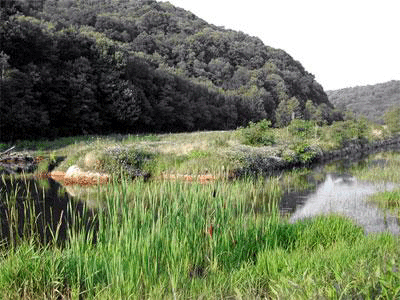Herbert Bayer – updated
Evidence that T. Allen Comp utilizes the knowledge he acquired to earn a Ph.D. in the History of Technology and American Economic History is evident in the following quote that pays tribute to Herbert Bayer:"When I first started talking about this idea that eventually became AMD&ART and won a national EPA Phoenix award among others, I’d show slides of the standard Acid Mine Drainage (AMD) treatment system, basically a series of rectangular ponds, and suggest we might be able to do more. Then I’d show Buster Simpson’s River Roll-Aids, Mel Chin’s Revival Fields and the Richards/Oppenheimer/Hargraves Bixby Park – but it was the images I had from Herbert Bayer’s Mill Creek Canyon Earthworks that finally got through to the audience. Here was a real problem with a real and art-full solution – it worked to solve the environmental problem and it worked to address something in the human soul as well. I showed Earthworks empty and I showed it full of people and, finally, my audiences started to understand how we might start with rectangular ponds to solve an environmental problem and grow that idea into a 35-acre park that treated acid mine drainage, created new wetlands and a new active recreation area while also addressing a need for deeper historical understanding and a more humane connection between past, present and even future. It was Herbert Bayer’s pioneering Earthworks that opened the door for AMD&ART."

AMD&ART was created by T. Allan Comp for the purpose of "artfully transforming environmental liabilities into community assets." Emphasis is on the word "comnmunity". Comp explains, "A lasting solution to the complex problems of environmental reclamation must be cultural and environmental. A scientific solution may clean the water, but a multidisciplinary solution has the power to both clean the water and to revive community spirit."
Comp activated this mission in a Vintondale, Pennsylvania in the midst of Appalachian coal country. Acid mine drainage (AMD), according to the EPA, is contaminating thousands of miles of streams. The evidence of industrial disturbances deep underground is glaring on the surface. Garish orange sediment announces the toxic effects of coal mining. Comp assembled an inter- and multi-disciplinary team to address this environmental calamity. Scientists provided the substance. Artists contributed the form. Fifteen years have passed. He explains that reclamation can be a celebration, “a chance to artfully redeem a legacy now too-often identified with mountains of waste coal, rust-coated streams, and economic depression, but equally responsible for the nation building, community development and personal achievement that made this country great. We’ve proven that treatment systems can become gardens, native plant arboretums, and places of learning…. – the good people of Kent should find that familiar.
Herbert Bayer might well have applauded Comp when he recommended establishing a new role for artists, “not as solitary visionaries, but as participants; not as some ultimately mystical or magical process, but an important, useful perspective; not as arbitrator, but as co-worker; one among many disciplines, all equally necessary (but none sufficient!) to the recovery and revitalization of this region and its peoples….Bayer’s “earthwork” and its continued survival as a seamless blend of both environmental solution and artful creation will inspire other projects in many places for generations.